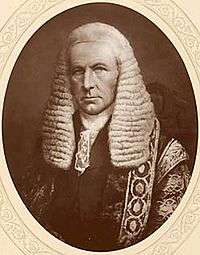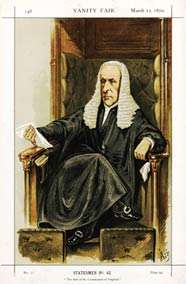Evelyn Denison, 1st Viscount Ossington
| The Right Honourable The Viscount Ossington PC | |
|---|---|
 | |
| Speaker of the House of Commons | |
|
In office 1857–1872 | |
| Monarch | Victoria |
| Preceded by | Sir Charles Shaw-Lefevre |
| Succeeded by | Hon. Sir Henry Brand |
| Personal details | |
| Born |
27 January 1800 Ossington, Nottinghamshire |
| Died | 7 March 1873 (aged 73) |
| Nationality | British |
| Political party | Whig, Liberal |
| Spouse(s) |
Lady Charlotte Bentinck (d. 1889) |
| Alma mater | Christ Church, Oxford |
John Evelyn Denison, 1st Viscount Ossington, PC (27 January 1800 – 7 March 1873) was a British statesman. He served as Speaker of the House of Commons from 1857 to 1872.
Background and education
Denison was born at Ossington, Nottinghamshire, the eldest son of John Denison (d. 1820), and the older brother of Edward Denison, bishop of Salisbury, Sir William Denison, colonial governor in Australia and India, and George Denison, a conservative churchman. He was educated at Eton and Christ Church, Oxford.
Political career

A Whig, he became Member of Parliament (MP) for Newcastle-under-Lyme in 1823,[1] being returned for Hastings three years later,[2] and holding for a short time a subordinate position in George Canning's ministry. Defeated in 1830 both at Newcastle-under-Lyme and then at Liverpool, Denison secured a seat as one of the members for Nottinghamshire in 1831. After the Great Reform Act he represented the southern division of Nottinghamshire from 1832 until the general election of 1837.[3] He was appointed High Sheriff of Nottinghamshire for 1839–40.[4]
Denison then represented Malton from 1841 to 1857,[5] and North Nottinghamshire from 1857 to 1872.[3] In April 1857 Denison was chosen Speaker of the House of Commons. He was sworn of the Privy Council at the same time.[6] Re-elected at the beginning of three successive parliaments he retained this position until February 1872, when he resigned and was raised to the peerage as Viscount Ossington, of Ossington in the County of Nottingham.[7] He refused, however, to accept the pension usually given to retiring Speakers. Denison gave an explanation – referred to as Speaker Denison's rule – as to how the Speaker should exercise his or her casting vote in the event of a tie.
The Speaker's Commentary
While in office, Denison formed the view that the public needed a plain, but complete and accurate, explanatory commentary on the Bible, and consulted some of the bishops as to the best way of supplying the work. Eventually the Archbishop of York undertook to organise the production of the commentary, under the editorship of Frederic Charles Cook, Canon of Exeter. A panel was appointed to advise the general Editor, comprising the Archbishop and the Regius Professors of Divinity of Oxford and Cambridge. Formally entitled The Bible Commentary, it became popularly known as "The Speaker's Commentary". It was first published in England, and subsequently in the United States by Charles Scribner's Sons.
Family
Lord Ossington married Lady Charlotte, daughter of William Bentinck, 4th Duke of Portland, in 1827, but he left no children. He died on 7 March 1873, and his title became extinct. His Ossington Hall estate passed to his nephew William Evelyn Denison, son of his brother Sir William Thomas Denison.[8]
Ossington Street in London was named in his honour. Lady Ossington died in 1889.
Styles of address
- 1800–1823: Mr J. Evelyn Denison
- 1823–1830: Mr J. Evelyn Denison MP
- 1830–1831: Mr J. Evelyn Denison
- 1831–1837: Mr J. Evelyn Denison MP
- 1837–1841: Mr J. Evelyn Denison
- 1841–1857: Mr J. Evelyn Denison MP
- 1857–1872: The Right Honourable J. Evelyn Denison MP
- 1872: The Right Honourable J. Evelyn Denison
- 1872–1873: The Right Honourable The Viscount Ossington PC
References
- ↑ leighrayment.com House of Commons: Na H-Eileanan An Iar to Newport
- ↑ leighrayment.com House of Commons: Haslemere to Herefordshire
- 1 2 leighrayment.com House of Commons: Northampton North to Nuneaton
- ↑ "No. 19704". The London Gazette. 9 February 1839. p. 214.
- ↑ leighrayment.com House of Commons: Macclesfield to Marylebone West
- ↑ "No. 21998". The London Gazette. 8 May 1857. p. 1616.
- ↑ "No. 23827". The London Gazette. 13 February 1872. p. 550.
- ↑ "Biography of William Evelyn Denison (1843–1916)". Manuscripts and Special Collections. University of Nottingham. Retrieved 15 November 2010.
External links
| Wikisource has the text of a 1911 Encyclopædia Britannica article about Evelyn Denison, 1st Viscount Ossington. |
- Works by or about Evelyn Denison, 1st Viscount Ossington at Internet Archive
- Hansard 1803–2005: contributions in Parliament by Evelyn Denison
- "Archival material relating to Evelyn Denison, 1st Viscount Ossington". UK National Archives.

- Portraits of (John) Evelyn Denison, 1st Viscount Ossington at the National Portrait Gallery, London

- Papers of the Denison family, held at Manuscripts and Special Collections at The University of Nottingham
- Anonymous (1873). Cartoon portraits and biographical sketches of men of the day. Illustrated by Waddy, Frederick. London: Tinsley Brothers. pp. 20–21. Retrieved 30 December 2010.
.svg.png)